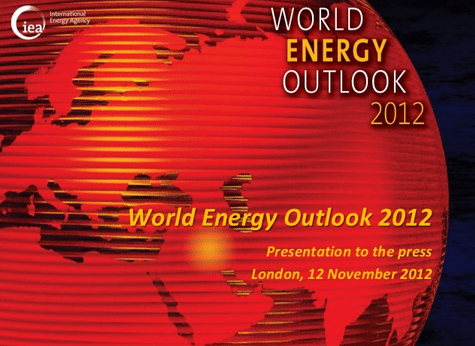
IEA Energy Outlook: U.S. Set to Redraw World Oil Map
Click for IEA Energy Outlook report
LONDON–A shale oil boom means the U.S. will overtake Saudi Arabia as the world’s largest oil producer by 2020, a radical shift that could profoundly transform not just the world’s energy supplies, but also its geopolitics, the International Energy Agency said Monday.
In its closely watched annual World Energy Outlook, the IEA, which advises industrialized nations on their energy policies, said the global energy map “is being redrawn by the resurgence in oil and gas production in the United States.”
The assessment is in stark contrast with last year, when it envisioned Russia and Saudi Arabia vying for the top position.
“By around 2020, the United States is projected to become the largest global oil producer” and to overtake Saudi Arabia for a time, the agency said. “The result is a continued fall in U.S. oil imports [currently at 20% of its needs] to the extent that North America becomes a net oil exporter around 2030.”
This major shift will be driven primarily by the faster-than-expected development of hydrocarbon resources locked in shale and other tight rock formations that have just started to be unlocked by a new combination of two technologies: hydraulic fracturing and horizontal drilling.
Within a decade, the IEA forecasts U.S. oil imports will fall by more than half, to just 4 million barrels a day from 10 million barrels a day currently. Much of this decline will be due to higher domestic production, but efforts to improve energy efficiency in the transport sector will also prove significant, the IEA said.
The IEA’s conclusions are partly backed by the Organization of the Petroleum Exporting Countries, which last week acknowledged for the first time that shale oil would significantly diminish its share of the U.S. market.
OPEC said the U.S. would import less than 2 million barrels a day in 2035, almost three-quarters less than it does today.
That’s not to say OPEC’s role will be marginalized globally. The organization’s share of global production will increase to 50% in 2035 from 42% today, with much of it going to Asia, according to the IEA.
The IEA hinted that newly found U.S. energy independence could redefine military alliances, with Asian nations replacing the United States in securing oil shipping lanes from the Persian Gulf.
According to the IEA, the U.S need for oil imports from the Middle East will fall to almost zero in the next 10 years, while almost 90% of Middle Eastern oil exports will go to Asia by 2035, creating a new trade axis.
“Asian countries should have much greater interest in the stability and security of their suppliers in the Middle East,” said Richard Jones, deputy executive director at the IEA.
Some in the U.S. are already questioning the reasons for keeping U.S. warships in the Persian Gulf. “It’s insane that we have the Fifth Fleet of the U.S. Navy tied up there to protect oil that ends up in China and Europe,” T. Boone Pickens, chief executive of energy-focused hedge fund BP Capital Management, was quoted as saying last week in U.S. magazine Parade.
The IEA said, however, that U.S. primacy in world oil production could prove short-lived.
“If no new [U.S.] resources are discovered and if the [oil] prices are not as high as today, then we may see Saudi Arabia coming back as the first producer again,” said the IEA’s chief economist, Fatih Birol.
The IEA also warned that the emergence of shale gas as a game changer in global energy has a downside risk, contributing to increased competition for water resources needed for energy projects.
Shale oil and gas are extracted by pumping water, sand and chemicals into the ground at high pressure to crack rocks open, a process known as hydraulic fracturing, or “fracking.” But the intensive use of water, “will increasingly impose additional costs,” and could “threaten the viability of projects” for shale oil and gas, and also biofuels, the agency said.
(c) 2012 Dow Jones & Company, Inc.

Subscribe for Daily Maritime Insights
Sign up for gCaptain’s newsletter and never miss an update
— trusted by our 109,177 members

Get The Industry’s Go-To News
Subscribe to gCaptain Daily and stay informed with the latest global maritime and offshore news

 Join The Club
Join The Club






